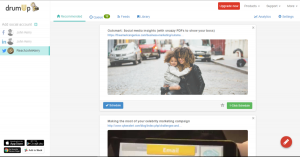A long, long time ago, the only way to really publicly shame a company was to take out an expensive ad in The New York Times.
Nowadays, all you have to do is open your Twitter app. And as fast as you can type “#badcustomerservice,” your complaint is in the public domain for all to see. Sure, you have to keep your criticism to 140 characters or less — unless you indulge in a multi-tweet rant — but that’s plenty of room to get your gripe across. “Don’t ever do business with #acmecompany their customer service is terrible” clocks in at a mere 75 characters, and a less sophisticated “#acmecompany sucks!” is only 19.
The negative repercussions of highly visible complaints can last for years. Just ask United Airlines, which many guitarists may still have second thoughts about flying on. And for the irate customer, there may be no better way to gain fast service than casually dropping an @Comcast into your tweet about your slow internet connection. Why wait hours for an email response when a tweet can bump you to the front of the line? Especially if you’re a celebrity with millions of followers, like Seth Rogen, who blasted Cathay Pacific for poor service on his Twitter feed last December.
But now all that public shaming may begin to dwindle, according to Hootsuite CEO Ryan Holmes in a recent article for Time. This April, Twitter announced that its Direct Messaging capabilities, which previously allowed private messages only between parties who each followed the other, would now allow private messages to anyone who accepted them. In other words, before Twitter changed its DM policy, Acme had to follow you and you had to follow Acme to be able to privately Direct Message each other. Now, as long as you and Acme both have the “anyone can Direct Message us” capability turned on, you can send private messages freely. That’s great news for massive organizations that can’t possibly follow all who follow them (British Airways has nearly 700,000 followers, for example).
But how do you fully leverage this new Direct Message capability as another channel for customer service?
Make Privacy a Positive
Even if unfounded, customers might well believe that they won’t get equal attention to their comments if they agree to go private instead of tweeting on the public stage. And they can certainly announce — via a public tweet — if companies won’t comment publicly but only via Direct Message, looking as if they have something to hide. So fight the interpretation that communicating quietly means being swept under the rug by highlighting its virtues as a communications channel. Assuming Direct Messages can be made secure, they will allow personal information like phone numbers and account information to be transmitted. In June, Twitter announced that it would soon remove its signature 140-character limit from Direct Messages, which would allow for true communication between customers and companies that can’t be articulated in two sentences. Of course, companies will also want to confirm the identity of the people they’re dealing with by referencing identifying information in customer profiles to ensure they’re engaging with actual customers and not imposters.
Embrace the Speed and Ease of Twitter
Twitter isn’t going anywhere, so the more companies acknowledge it as an important CX channel, the more likely customers will take it seriously as a means to get a response. That means actively publishing the Direct Message option on Customer Support web pages alongside chat, email, and phone contact information. (And, of course, noting the option on the company’s Twitter profile.) And companies should respond to Direct Message inquiries with the same attention they give to other fast-paced channels such as phone and chat. Studies suggest that Twitter users expect a reply from a company within 60 minutes.
An hour may seem fast compared to email, but the speed of social may help contact center agents respond to customers faster and more efficiently than most other channels, ultimately keeping costs down. In March, Comcast — no stranger to public tweet-shaming — added 40 dedicated social media representatives. In case a situation can’t be handled over Twitter or Facebook alone, make sure your contact center has omnichannel routing support to enable seamless transitions from social media agents to your phone, email, or live-chat teams.
Don’t Stop Tweeting Out Loud
The reality is that not all customers are going to go quietly, and some complaints might actually be better handled en masse. Ask online food-ordering company Seamless, which was bombarded with angry tweets about their website redesign last month. The only practical response there would be to reply via public tweets — and far more efficient for Seamless, too, as the complaints centered around a handful of specific concerns (people are really attached to their order history).
If done well, public tweeting can be encouraged, but more as a help-desk back and forth, as Xbox does superbly, responding to 5,000 questions in one week, with an average response time of less than three minutes. Another one to watch: UK grocery chain Tesco, whose tweet replies are dominated by customer service responses to individual concern, including communicating with other support teams on the back end and then returning to Twitter to provide a response. That kind of superior customer experience benefits from public exposure.
Face(book) the Future
As long as you are folding Twitter into your CX arsenal, you might as well start planning across your whole social media portfolio. Facebook users are equally apt to launch their complaints via posts on corporate pages (a fact that a comedian recently took advantage of). In March, Facebook introduced Businesses on Messenger. This means the more than 600 million people who use Facebook messenger will soon be able to communicate with businesses directly via the messenger app. Companies are able to use the new capability to offer, for example, sending shipping updates via messenger. Customers can then reply back — which is not always possible via traditional SMS text support channels.
It’s a brave new world, and companies need to keep getting braver. Customers are unafraid to use social media to publicly decry organizations that don’t meet their expectations. Companies would be smart to be equally courageous in responding just as openly. But what’s just as smart — and now possible — is to find a way that encourages private, individual communication even via social media platforms originally designed for mass broadcasts. If you want people to stop shouting, find a way for them to whisper in your ear. It can build a more personal connection, and it can save your reputation too.
(229)




